LOCATION
VENUE
Prague Congress Centre

10 mins from the centre
9 300 seats
+ 50 halls
Situated next to the beautiful Vysehrad area the Prague Congress Centre provides you with one of the most stunning panoramic views over the city. Vysehrad also offers peaceful green parks encouraging relaxation and the perfect location to catch up with cultural and spiritual matters in your free time. The congress centre is in close proximity to many hotels and Vysehrad Metro station is accessible within only 2 minutes’ walk. When traveling to the very heart of the city from the congress you can be there in less than 10 minutes.
We believe this neo-functionalist building is an ideal place to meet, share and be inspired.
Venue Floorplan
Click here to see the detailed plan of the venue.
Click here to see the exhibition floorplan.
Address

Prague Congress Centre
5.kvetna 65
140 21 Prague 4
Czech Republic
Map
Venue Street View
GPS
GPS: 50.062112, 14.428886
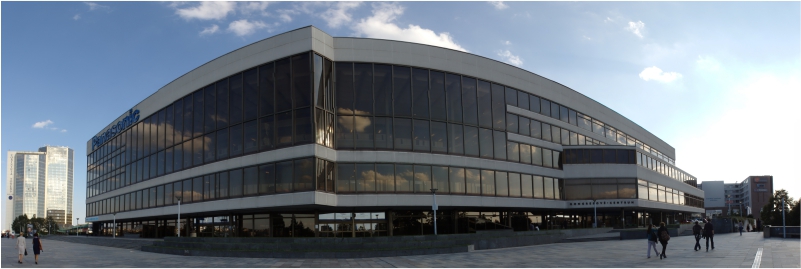
How to get there from the Airport?
Should you need an assistance please contact our hostesses in the arrival hall of Terminal 2.


Airport Information
Nonstop Phone Line: +420 220 111 888
AFTN: LKPRYDYX
SITA: PRGCZ7X, PRVCZ7X
www.prg.aero/en
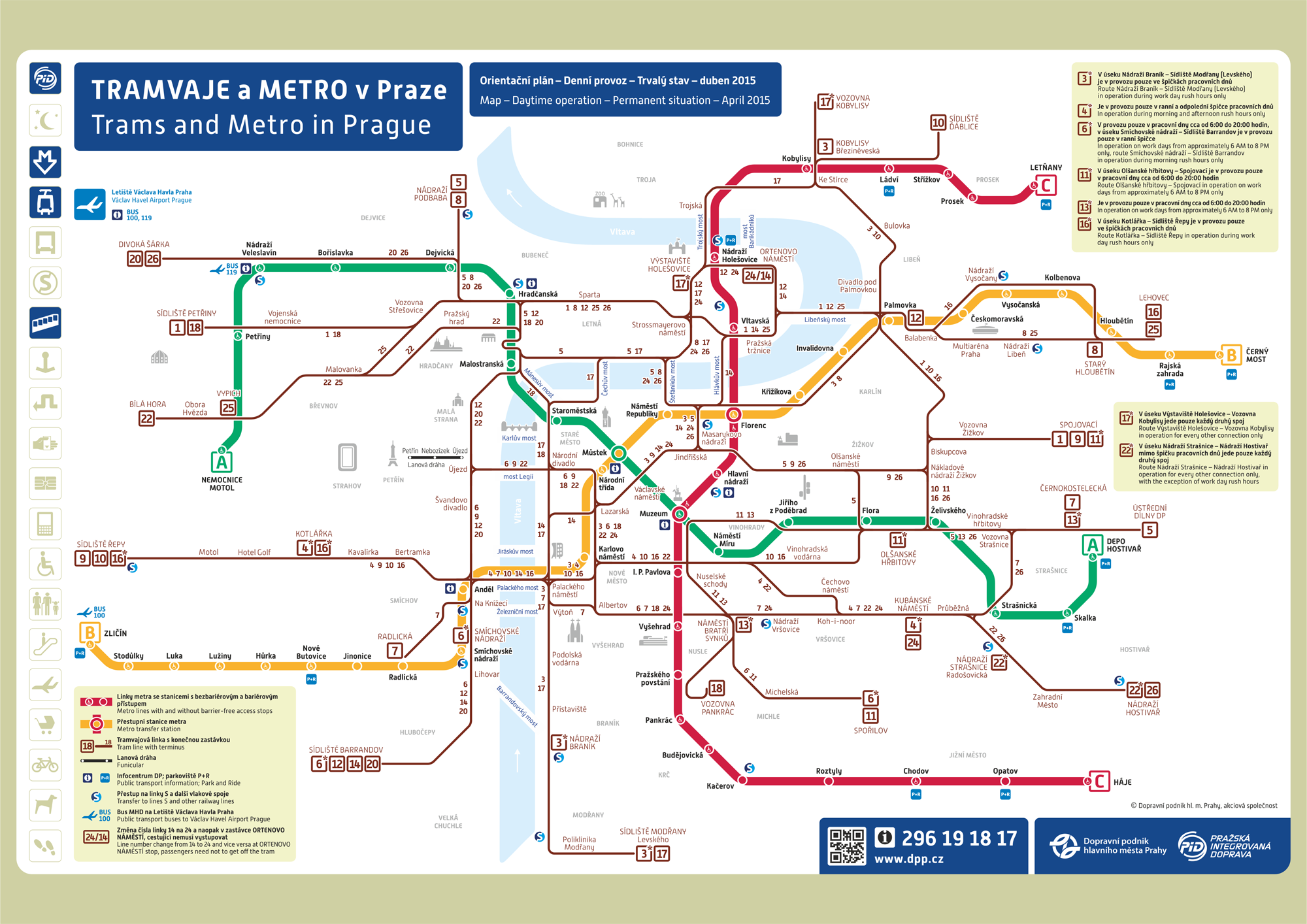
By Metro (Subway)
The Prague Congress Centre is right next to Vysehrad Metro station (line C).
By Tram
The nearest tram stop is Svatoplukova. It is in Nusle, directly underneath Nusle Bridge (Nuselsky Most). Tram numbers 7, 18 and 24 stop here. After getting off the tram, walk under the railway line and up the steps through the park straight to the congress centre which you will be able to see above you.
By Bus
The main bus station is located in Florenc and it is 4 stops by Metro line C in the direction of Haje.
By Taxi
When taking a taxi, make sure the taxi is equipped with a permanently installed yellow roof lamp with the TAXI sign in black letters. The registration number, company name, price list including the base rate, rate per kilometre and one-minute-waiting rate must be displayed on both front doors of the cab. These prices must correspond with the prices set on the meter in the cab. Customers are recommended to order a taxi with non-stop dispatching offices where information on fares is available in advance.
In the city centre taxis are easy to hail from the street but we strongly recommend that you use hotel taxis or obtain taxis by phone through the radio taxi service e.g. AAA (+ 420 14 014), City Taxi (+420 257 257 257) or Speed Cars (+420 224 234 234).
The boarding charge: approximately 40 CZK.
Journeys within the city: approximately 28 CZK/ 1 kilome¬tre. Do not board the taxi without finding out if there is a fixed rate.
How to get there by car?
-
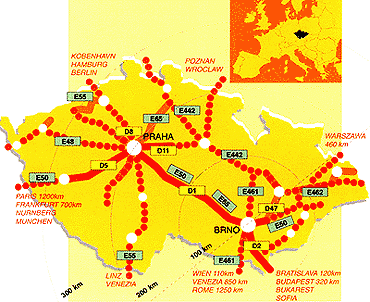
From the North on the D8 Motorway
If you are travelling from the north along the E55 motorway in the direction from Dresden, follow the signs to the centre. After you have crossed the Vltava river drive through the centre in the direction of Nusle Bridge (Nuselský Most). After crossing the bridge turn right and follow the signs to the Prague Congress Centre. At the roundabout turn right towards the ÖMV petrol station. This will take you to the underground car park.
-
From the South on the D1 Motorway
If you are coming on the motorway from Brno, Vienna or Bratislava, follow the signs to the centre. You will come to a street named ‘ulice 5. května’. Before reaching Nusle Bridge (Nuselský Most) turn right towards the Corinthia Towers hotel and then follow the signs to the Prague Congress Centre. At the roundabout turn right towards the ÖMV petrol station. This will take you to the underground car park.
-
From the West on the D5 Motorway
If you are coming by motorway from Rudná, drive along the Prague ring road (Pražský Okruh) to the centre. After crossing the river you will join the Jižní Spojka. Follow the signs to the centre then to a street named ‘ulice 5. května’. Before reaching Nusle Bridge (Nuselský Most) turn right towards the Corinthia Towers hotel. You will then come to a roundabout where you should turn right towards the ÖMV petrol station. This will take you to the underground car park.
-
From the East on the D11 Motorway
When coming from Hradec Králové, as you approach the centre of Prague follow the signs in the direction of Černý Most and then for Centrum-Karlín. You will reach Těšnov Tunnel (Těšnovský tunel). After going through the tunnel, turn left immediately heading to the centre so that you join the arterial road (Magistrála). Drive along this road through part of the city centre. You will then reach Nusle Bridge (Nuselský Most). After crossing the bridge turn right and follow the signs to the Prague Congress Centre. At the roundabout turn right towards the ÖMV petrol station. This will take you to the underground car park.
PRAGUE
The capital city of the Czech Republic is poetically considered as the heart of the European continent. Its history is deeply rooted in every building and you can feel the city’s cultural spirit in every step. Different architectural styles have been preserved throughout wars and years of the communist era providing visitors with a valuable insight into past images of Prague. As visitors travel along the Vltava River they are taken on a historical rollercoaster; ranging from the Prague Castle, being the largest historical complex to the Dancing House representing the city’s modern contemporary architecture on the opposite side of the river. However, Prague is not only a city of historical monuments but also a city for living, where culture is an integral part of all things. It is not surprising to find that it has been a source of inspiration for many famous Prague residents and personalities, such as Einstein, Kafka, Mozart and van Beethoven.

Today, many years on from the Velvet Revolution, Prague has established itself as the meeting point of the East and West. The city is now host to multiple scientific conferences and cultural events and is now well recognised in the top 10 event destinations worldwide. The same goes for movie makers who simply love coming to Prague to enhance the scene and backdrop of their movies. You may have seen Prague in motion pictures such as The Bourne Identity (2002), The Illusionist (2006), Casino Royale (2006), Mission: Impossible (1996) and Amadeus (1984).
Prague isn’t just a city, but an entity of some kind. -Sezin Koehler
For more information, visit www.praguewelcome.cz
5 things not to miss in Prague?

Be Enchanted by Old Town Square
It's like stepping inside a fairy-tale picture book. The square seems especially huge because of the contrast with the narrow streets leading into it. But size alone is not what makes the square so impressive, this task is accomplished by the remarkable architecture enclosing the space. Highlights are the Old Town Hall, with the world's oldest working Astronomical Clock on its tower and the Týn and St. Nicholas Churches.

Hike up to Prague Castle
From its hilltop perch the Prague Castle looms over the city. It has been home to Kings of Bohemia, Holy Roman Emperors and presidents of both Czechoslovakia and the Czech Republic since the first fortress was constructed here in the year 870. Prague Castle remains the seat of government for the Czech Republic and there is a noticeable military and security presence.

Eat Lots of Delicious Dumplings
If you would like to try some typical Czech cuisine you should order some dumplings – Svíčková na smetaně served with dumplings, whipped cream and cranberries, Vepřo-knedlo-zelo (roast pork with dumplings and sauerkraut) or sweet dessert dumplings with fruits.

Cross the Charles Bridge
More than just a bridge, it's a history lesson, a performance venue, a shopping centre and a place of supernatural phenomenon. From the earliest days of Prague this bridge, across the Vltava River has been the focal point of the city. King Vladislaus II built the first bridge in 1170. In 1342, when the original structure was washed away in a flood, King Charles IV replaced it with the version that stands today.

Have one of the Best Beers in Europe
Prague is the best city in Europe for beer lovers. This may sounds outlandish at first as other European capitals certainly might offer a greater variety, with a few more kinds of beer available. However on the other hand, in Prague good beer — and often amazingly good beer — is on just about every corner. It’s a culture that needs to be experienced to understand.
Prague Transportation
Prague enjoys a widely used and inexpensive underground, tram and bus system. For more information about the Prague public transportation visit www.dpp.cz.

Metro (Subway)
The Prague Metro network consists of 3 lines designated by letters and differentiated in colour:
A - green colour (Depo Hostivař station - Motol station)
B - yellow colour (Cerny most station - Zlicin station)
C - red colour (Letňany - Haje station).
Possible transfers at Museum station (lines A and C), Mustek station (lines A and B) and Florenc station (lines B and C). Metro operates daily from 5 a.m. to 12 p.m. During peak hours trains run every 1 or 2 minutes and during off-peak hours at least every 10 minutes.

Trams
Daytime operation is from 4:30 a.m. to 24:00 a.m. Night-time operation is from 00:30 a.m. to 4:30 a.m. and is provided by tram numbers 51 to 58 with traffic intervals of 30 minutes. The central transfer-station for night-time lines is Lazarska stop. Complete am schedules are located at individual stops or online.

Bus
The daytime and night-time operation of buses is similar to tram operation. Night-time service is provided by bus numbers 501 to 514. Complete bus schedules are located at individual stops or online.

Prague City Transport Fares
Travelling by city transport is possible with a valid ticket only. Passengers have to obtain their tickets before boarding the vehicle or entering the Metro system.
The Prague public transport system uses two types of single-trip tickets:
|
30´ ticket |
90´ ticket |
|
Adults |
24 CZK |
32 CZK |
|
Children 6 -15 years |
12 CZK |
16 CZK |
|
Children under 6 |
free |
free |
If necessary, you can buy a 90-minute ticket directly from the driver for 40 CZK.
Both tickets can be used on any type of public transportation and allow transfers between lines (subway to subway, tram to tram etc.) and transfers between different types of transport (subway to tram, tram to bus etc.) for up to 30 or 90 minutes from validation.

Tickets are sold through yellow ticket vending machines (also in English, coins only), at ticket offices located at some metro stations, at a Tabák/Trafika, at some newsstands and at tourist information centres.
You can also buy tickets by using your mobile phone and sending the text message "DPT24" or "DPT32" to the number 902 06. Your ticket will usually be sent to your phone within one minute.
A ticket must be punched at the entrance to the metro station or when boarding the tram/bus to mark the start of the validation period. If you requested a ticket by SMS, you must have received your ticket before you enter the vehicle or the paid zone on the subway.
Click here to see detailed information on public transport fares.
Ticket Inspection

The validity of tickets can be checked by officials of the Prague public transport company at any time during travel or stay in the Metro system. The ticket inspector is entitled to ask the passenger to produce his or her valid ticket, to confiscate invalid tickets and to collect a penalty (1500 CZK, if paid at once 800 CZK) in case of travel without a valid ticket. In case of unpaid freight / luggage the inspector collects a penalty (200 CZK, if paid at once 100 CZK). To prove their identity inspectors produce yellow-and-red badges. They issue receipts for the penalty amounts.
Taxi

When taking a taxi, make sure the taxi is equipped with a permanently installed yellow roof lamp with the TAXI sign in black letters. The registration number, company name, price list including the base rate, rate per kilometre and one-minute-waiting rate must be displayed on both front doors of the cab. These prices must correspond with the prices set on the meter in the cab. Customers are recommended to order a taxi with non-stop dispatching offices where the information on fares is available in advance.
Bike Rental
Explore Prague in an exciting way connected with a heathy life style. You can enjoy either sightseeing in the city centre or relaxing along the Vltava River.
www.okolo-bikes.cz
www.prahabike.cz
www.citybike-prague.com
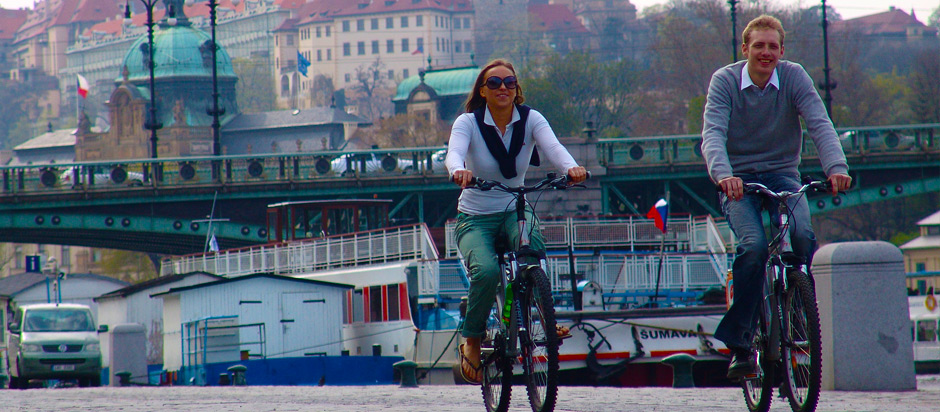
Getting to Prague
By Plane
-
Easily accessible from all major European cities (max. flying time 2.5 hours)
-
Direct flights from 128 destinations all over the world
-
Two terminals – Terminal 1 and 2
-
Many low cost airline options
By Car

Distance to European cities:
-
Berlin 350 km
-
Zürich 694 km
-
Frankfurt am Main 508 km
-
Amsterdam 877 km
-
Budapest 525 km
-
Bratislava 328 km
-
Krakow 540 km
By Train
Prague has several train stations, but international trains are likely to arrive at the Main Railway Station (Hlavní Nádraží). There are also some international arrivals at Holešovice Station (Nádraží Holešovice). These stations are connected to the underground (red line C) and go directly to the Prague Congress Centre (Vyšehrad).
CZECH REPUBLIC

The Czech Republic is a rather small but charming country situated in the very heart of Europe. Since medieval times it has been a crossroad of intellectual, artistic and culinary influences, but also a centre of discord.
After a long isolation caused by the communist regime, Czech is increasingly becoming a cultural and ethnic melting pot, in line with the growing trend of globalisation. This is also reflected in the available cuisine. From one day to the next locals enjoy both traditional dishes such as goulash or roast duck with dumplings to new hip options such as Vietnamese “Pho” soup, Sushi or Thai curries. Still, the most traditional meeting spot remains to be the pub where you can have a glass of some of the best and most famous beer in the world.
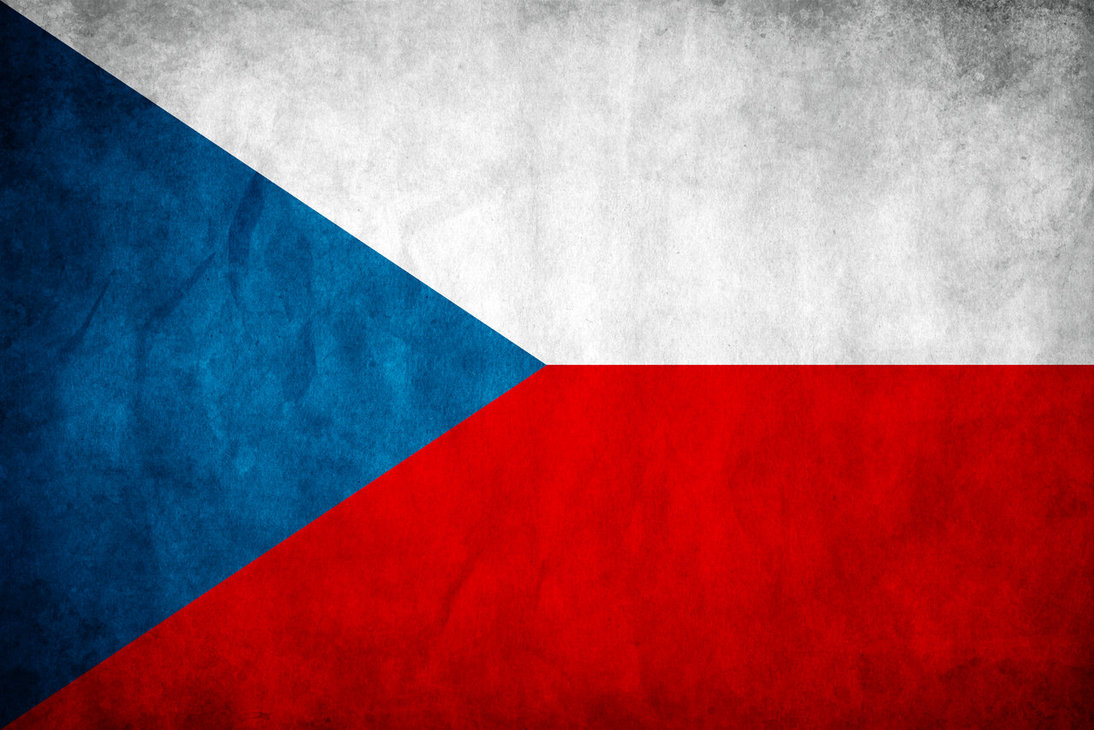
Despite its small land area, Czech’s landscape is highly diverse - from mountains creating natural borders in all directions to the fertile scenic lowlands in South Moravia. The Czech Republic has a moderate continental climate with warm summers and cold and snowy winters. The temperature between seasons differs substantially due to Czech’s landlocked geographical position.

The official language is Czech. It is very similar to Slovak or Polish. They all belong to the group of West Slavic languages. Czech is a particularly difficult language to learn due to its complicated set of grammatical rules. However English is widely spoken and understood, especially within the main cities.
Bohemia, the official name of the region is derived from the Celtic tribe Boii, who were the first inhabitants of the area we now call Bohemia. There is also definitive evidence that the area was once occupied by the Slavs in the 6th century A.D. The long and rich history of Bohemia and Moravia can be traced through Samo´s Empire, the Great Moravian Empire, the reign of the Premysl´s, the Luxemburg and Habsburg dynasties and the Catholic expansion leading up to the Thirty Years War. The decline of the Austro-Hungarian Empire led to the birth of the Czechoslovakian Republic. After surviving the German occupation during the 2nd World War and forty years of communism, the totalitarian regime symbolically ended in one day - the Velvet Revolution in November 1989.

After years of being persecuted, the writer and philosopher Vaclav Havel became president with a democratic vision. The Czech Republic and Slovakia parted ways peacefully on the 1st January, 1993. As one of many historical paradoxes, the process of convergence with the European community started soon after and culminated in the Czech Republic joining the European Union on the 1st May, 2004.

Many Czech personalities have become famous throughout the world. The Holy Roman Emperor Charles IV, had a significant role in European history. In the work of John Amos Comenius, who is considered to be the father of modern education you, will find similar thoughts and concepts as Maria Montessori. Masterpieces from composers Bedrich Smetana, Antonin Dvorak and Leos Janacek are still played worldwide. Novels written by the mysterious Franz Kafka and innovating Karel Capek are timeless. To this day the voice of opera singer Emma Destinn is still impressive. The Czech Republic is also a producer of globally famous athletes such as football player Petr Cech, ice hockey star Jaromir Jagr and Wimbledon winner Petra Kvitova along with Olympic medallist speed skater Martina Sablikova.
Commercially, the Czech Republic has grown significantly since the Velvet Revolution and throughout the 90´s it has built its reputation as a sophisticated congress destination. It is also a country where historical monuments and entire towns have been marked as world heritage sites. Of course when discussing tourism in Czech Republic, one cannot overlook the overwhelmingly popular tourist destination of Prague. The city is generally considered to be one of the most beautiful world capitals with an exquisitely preserved historical centre. Prague continues to be voted as one of the top 5-10 tourist destinations worldwide by the likes of Trip Advisor and Conde Nast Traveller.
Many towns and historical monuments are registered as UNESCO world cultural landmarks: Kutna Hora, Cesky Krumlov and Olomouc just to name a few. Terezin is also often explored by tourists, but unfortunately its history is stained by war. Once a fort town from the end of the 18th century, it was transformed by Nazis into a Jewish ghetto during the war. Karlovy Vary (Karlsbad) and Marianske Lazne (Marienbad) are glowing assets of the Czech Republic due to the existence of curative mineral spring spas. Jachymov, another town in the countryside, is also well known for its rare radioactive springs.
Climate
Prague is a city with a “mild continental climate”. The average temperature in July/August varies between 18 - 25 °C. For detailed info about current weather please follow this link.
Money
The official Czech currency is the “Koruna”, often translated as “Crown”. Although the country hasn’t transferred to the Euro yet it is possible to use it as a payment method in most restaurants and shops. Payment by credit card is an equally widely spread option and most hospitality venues offer card payments. ATM machines are widely accessible, however we recommend checking your bank fees beforehand. In case you decide to exchange money in one of the exchange offices in Prague, we suggest checking the rates and commissions carefully, as they may differ by company. The recommended exchange office with reliable rates is one called “Exchange”. Rates suggested by the national bank of Czech Republic are listed on this webpage.
Tipping
No particular rules apply for tipping and the most common way to tip is to round the amount up. In more expensive restaurants, a 10% tip is suggested, but is not obligatory.
Useful links
www.czech.cz
www.czechtourism.com
www.myczechrepublic.com
Basic facts
|
Capital |
Prague |
|
Government |
Parliamentary Democracy |
|
Currency |
Czech Crown (CZK) - "koruna" |
|
Area |
total: 78,866 km² |
|
Population |
10,510,000 (Sep 2012 est.) |
|
Language |
Czech |
|
Electricity |
230V/50Hz (European plug) |
|
Country code |
420 |
|
Internet TLD |
.cz |
|
Time Zone |
UTC + 1 (winter time) UTC+2 (summer time) |

































